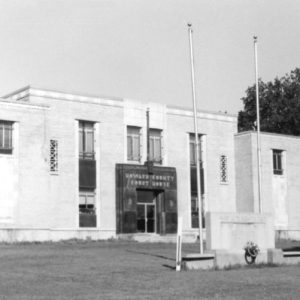calsfoundation@cals.org
Howard County Courthouse
The Howard County Courthouse is located on 421 North Main Street. It stands at the gateway of downtown Nashville (Howard County), which encompasses the city’s commercial and government districts. The Arkansas Historic Preservation Program recognizes the two-story building as architecturally and historically significant, as it stands as a visible result of the New Deal policies of the 1930s. The National Park Service added it to the National Register of Historic Places on June 14, 1990.
At the county’s creation in 1873, the Nineteenth Arkansas General Assembly made Center Point (Howard County) the county seat due to its convenient geographical location. Meanwhile, the economic hub centered on Nashville, with cotton, wool, and peaches driving economic output. After the Arkansas and Louisiana Railway Company opened a line between Nashville and Hope (Hempstead County) in 1884, Nashville grew in size and population as commerce came in from the region. In 1905, a voter referendum moved the county seat from Center Point to Nashville.
In 1929, the Great Depression hit Nashville. Government assistance through Franklin Delano Roosevelt’s New Deal programs stabilized unemployment. In 1939, the Federal Emergency Administration of Public Works, more commonly called the Public Works Administration (PWA), awarded Howard County an appropriation for a new county courthouse. (Like the Works Progress Administration, the lesser-known PWA constructed public buildings but did so less frequently and handled projects with larger budgets.) The construction used local designers and labor, which allowed building plans to deviate from the aesthetics common with New Deal–era projects. Erhart & Eichenbaum, an architectural firm in Little Rock (Pulaski County), designed the courthouse, and E. V. Bird, a contractor from Fayetteville (Washington County), built it. The total budget was $120,000, of which Howard County contributed $66,000.
The yellow brick courthouse has a symmetrical “H” shape. It was designed in the Art Moderne style, which was popular in the 1930s and considered a late variety of the Art Deco architecture. It is similar to other Art Deco courthouses in Arkansas, with the exception of green and black marble from Batesville (Independence County) framing the principal entrances and adjacent windows on the exterior. Because marble is an expensive finish, its placement on the exterior makes the building unique for a courthouse built in a rural country during the Great Depression. Other exterior features include ornamental concrete forming geometric shapes on the cornice and surrounding the windows. A war memorial stands on the lawn listing names of World War I and World War II casualties from Howard County.
Much of the interior contains its original features from 1939, including the ceramic tile floors, light fixtures, Venetian blinds, hand-carved woodwork, and furniture. The courtroom is relatively large and occupies the entire second floor. It can seat more than 400 people, which is unusual for the courthouse of a small county.
Later updates to the building include an emergency response system to summon police if needed. In June 2015, the Arkansas Historic Preservation Program awarded Howard County a $170,000 grant for a new heating and air system for the building.
For additional information:
Balch, John. “Howard County Courthouse Emergency System Plans for Upgrade.” Nashville Leader, June 5, 2015.
———. “Howard County to Get $170K Grant for Courthouse Restoration, $20K for Howard County Historical Society.” Nashville Leader, June 19, 2015.
Gill, John Purifoy, and Marjem Jackson Gill. On the Courthouse Square in Arkansas. N.p.: 1980.
“Howard County Courthouse.” National Register of Historic Places nomination form. On file at Arkansas Historic Preservation Program, Little Rock, Arkansas. Online at http://www.arkansaspreservation.com/National-Register-Listings/PDF/HO0012.nr.pdf (accessed November 18, 2020).
Jared Craig
Arkansas Historic Preservation Program
 Early Twentieth Century, 1901 through 1940
Early Twentieth Century, 1901 through 1940 Historic Preservation
Historic Preservation Howard County Courthouse
Howard County Courthouse 




Comments
No comments on this entry yet.